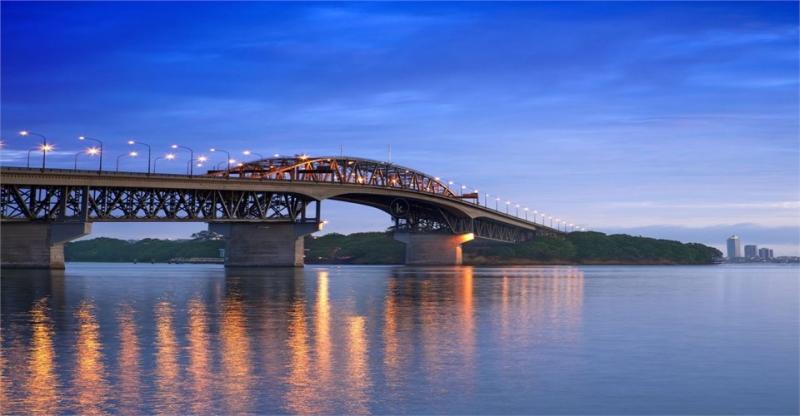Top New Zealand's most famous architectural works #1
New Zealand is an island nation with a developed market economy in Oceania located in the Southwest region of the Pacific Ocean. The culture of this country is influenced by the Maori people and adapted from East Polynesian culture. However, due to the introduction of Western culture, New Zealand's architectural works have a modern style. To understand better, let's explore the unique architectural works of this island nation with Toplist.
Auckland Ferry Terminal
Auckland is one of New Zealand's most dynamic and busiest cities. Therefore, it would be truly a pity to miss this stop in the itinerary. Auckland is also known as the city of sailing and if you want to go to some tourist destinations in this city, ferries are a popular means of transportation. Auckland Ferry Terminal is one of the city's typical architectural works. This project was built in 1912, following the Edwardian-style architecture popular during the reign of King Edward IV (England).
Considered one of the world's leading resort islands, Waiheke Island, where the Auckland ferry terminal is located, has a total area of 92 square kilometers and is home to pristine beaches, coastal headlands, vineyards, and olive groves. and beautiful seaside villages. With this round-trip ferry ticket, you will take a 40-minute journey from Auckland to Waiheke Island located in the Hauraki Gulf. 
On the journey, you will travel along beautiful islands and coastlines. In addition, you can also enjoy onboard services such as a cafe and bar with a variety of New Zealand beers, wines, hot and cold drinks.
Auckland Harbor Bridge
The Auckland Harbor Bridge is an eight-lane motorway bridge over Waitematā Harbor in Auckland, New Zealand. It joins St Marys Bay on the Auckland side with Northcote on the North Coast. It is part of State Highway 1 and the Auckland Northern Expressway. The bridge is operated by the New Zealand Transport Agency. It is the second longest road bridge in New Zealand and the longest bridge in the North Island. The original four interior lanes, opened in 1959, were constructed of box truss.
The two lanes that were added to each side in 1968 -1969 were of orthorhombic box structure and cantilevered off the original piers. The bridge is 1,020 m long, with a main span of 243.8 m, 43.27 m above high water, allowing ships to access the deep water wharf at Chelsea Sugar Mill, one of the few such wharves in the western part of the bridge. The proposed Te Atatū port and bridge have not yet been built.
Although often considered an Auckland icon, criticism has included complaints that it imitates the Sydney Harbor Bridge in copycat fashion. Many people consider building the bridge without walking, cycling and rail facilities to be a major oversight. However, in 2016, "SkyPath", an auxiliary structure providing a walking route, received Council funding approval and planning consent. About 170,000 vehicles cross the bridge every day, including more than 1,000 buses, carrying 38% of all passengers during the morning rush hour.
Auckland Art Gallery Toi o Tamaki Building
The Auckland Art Gallery Toi o Tamaki building is considered almost unique in its combination of modern architecture and heritage architecture. The plus point for this project is the green space and environmentally friendly materials. Under the talented hands of architect Francis - Jones Morehen Thorp, the Auckland Art Gallery Toi o Tamaki Building was honored to receive the most prestigious award at the 2013 World Architecture exhibition - World Building of the year. 
Not long ago, this work also won the WAF Inside award in the Culture category. Toi o Tamaki Art Gallery, consisting of the existing building and the extension. The extension is designed to fit into the old courtyard. The expanded space is covered by a roof system, consisting of 4 rows shaped like stylized tree canopies, covered with wood, surrounded by large glass walls.
The expanded building block not only provides and adds more entrances, areas, and perfect harmony, but also enriches, diversifies, and creates new vitality for the old building block: The expanded building block Designed very modernly, with an open space structure, bringing nature deep into the building, complementing the closed space with many decorative details of the old building. Modern large glass and wood materials complement the brick, plaster and stucco materials with many details of the old building. The liberality in form of the expanded building complements the formal and refined shape of the old building. The expanded building block provides many communal architectural spaces, connecting activities inside and outside the house, which old buildings with old architectural design theory and construction technology cannot have. .





























![[ℕ𝕖𝕧𝕖𝕣] 𝕊𝕖𝕝𝕝 𝕐𝕠𝕦𝕣 𝔹𝕚𝕥𝕔𝕠𝕚𝕟 - And Now What.... Pray To The God Of Hopium?](https://cdn.bulbapp.io/frontend/images/79e7827b-c644-4853-b048-a9601a8a8da7/1)



![[LIVE] Engage2Earn: Save our PBS from Trump](https://cdn.bulbapp.io/frontend/images/c23a1a05-c831-4c66-a1d1-96b700ef0450/1)








